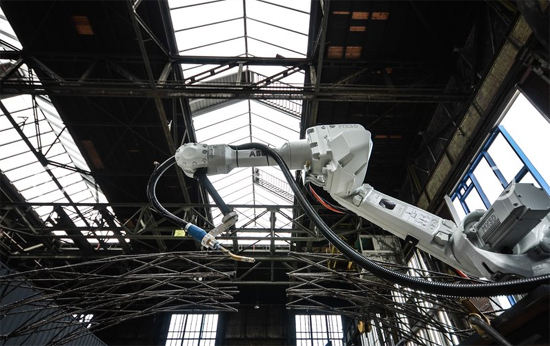
Prototype of the 3D printed bridge under construction. Courtesy of MX3D.
Latest News
June 17, 2015
Additive manufacturing (AM) has the potential to become a serious tool for both small and large-scale construction. Some companies plan on using the technology to construct parts for pre-fab buildings that can be rapidly assembled on site, while other plans prefer to use AM in situ. Either way, the future of construction is likely to be changed by AM.
A collaboration between Heijmans and MX3D is working on a different type of construction effort using 3D printing. The team is in the process of adapting its freeform fabrication technology to erect a new pedestrian bridge in Amsterdam. If the project succeeds, it would become the first bridge built with AM in the world.
 Prototype of the 3D printed bridge under construction. Courtesy of MX3D.
Prototype of the 3D printed bridge under construction. Courtesy of MX3D.“I strongly believe in the future of digital production and local production, in ‘the new craft,’” said designer Joris Laarman. “This bridge will show how 3D printing finally enters the world of large-scale, functional objects and sustainable materials while allowing unprecedented freedom of form. The symbolism of the bridge is a beautiful metaphor to connect the technology of the future with the old city, in a way that brings out the best of both worlds.”
MX3D is the result of Laarman’s interest in developing a new type of AM that didn’t rely on flat printing areas or tubs filled with resin to build new objects. As reported last year by Rapid Ready, MX3D’s process involves the use of a precision robotic arm connected to a print head. Rather than extruding a stream of material, the print head produces metal droplets that fuse together to form solid lines.
The bridge project envisions using a pair of the robotic printers to build the bridge largely autonomously. This would allow construction to continue day and night, though I’m not sure how well it’d fare during rainfall. While a pedestrian bridge might sound like a modest undertaking, there’s no real reason the same construction process couldn’t be scaled up by adding more robot workers to create much larger structures.
Amsterdam will announce the exact location of the bridge later this year. Once constructed, the bridge will join another 3D printed architectural project in the city, assuming the canal house is completed by that point. Below you’ll find a short video about the project.
Subscribe to our FREE magazine, FREE email newsletters or both!
Latest News
About the Author
John NewmanJohn Newman is a Digital Engineering contributor who focuses on 3D printing. Contact him via [email protected] and read his posts on Rapid Ready Technology.
Follow DE





